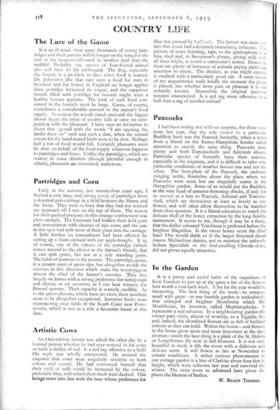Partridges and Corn
Early in the autumn, just twenty-four years ago, I flushed a very large and strong covey of partridges from a deserted gun-carriage in a field between the Marne and the Aisne. They were so busy that they had not noticed my approach till I was on the top of them. The reason for their packed presence in this strange confinement was plain enough. The Germans had hidden their field-guns and ammunition with sheaves of ripe corn; and the ears in this spot had spilt most of their grain into the carriage. A little further on concealment had been effected by setting up a sham orchard with cut apple-boughs. It is, of course, one of the virtues of the partridge (which comes second-to the plover as the farmer's friend), that it eats spilt grain, but not as a rule standing grain. The habit of sparrows is the reverse. The partridge, again, is a greater eater of green tips, but altogether avoids the excesses in this direction which make the wood-pigeon almost the chief of the farmer's enemies. They live largely on leaves with a strong preference for turnip-tops and clover; or on occasion, as I can bear witness, for Brussel sprouts. Their capacity is scarcely credible. As to the green plovers, which have no vices, their numbers seem to be altogether exceptional. Immense flocks were mantruvring over fields in the South Coast near Portsmouth, which is not as a rule a favourite haunt at this date.






















 Previous page
Previous page